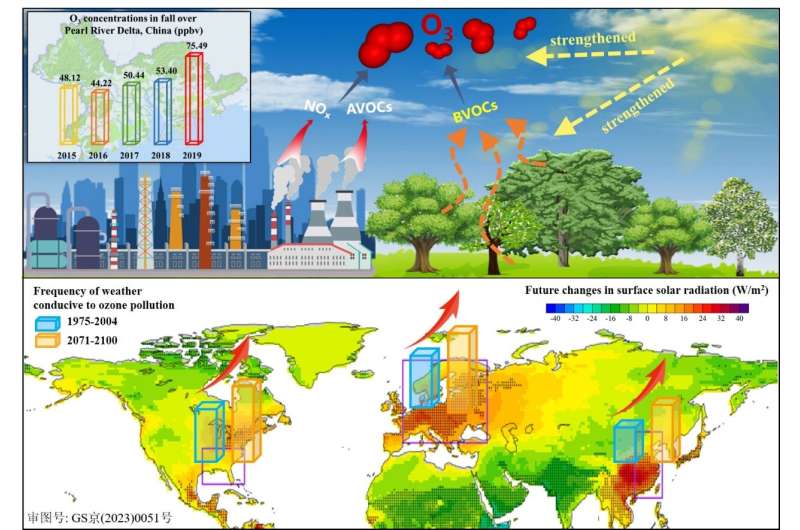This article has been reviewed according to Science X's editorial process and policies. Editors have highlighted the following attributes while ensuring the content's credibility:
fact-checked
trusted source
proofread
High downward surface solar radiation conducive to ozone pollution more frequent under global warming

Elevated near-surface ozone pollutes many parts of the world, exerting consequential impacts on human health in ozone-prone regions, including southeastern China, the southeastern United States, and Europe. Key meteorological conditions, such as downward surface shortwave radiation, intensify ozone pollution, yet how these meteorological conditions or associated mechanisms respond to global warming remains unknown.
"Taking advantage of 5-year-long daily observations in China over the 2015-2019 period, we first identify an extraordinary ozone increase in fall 2019 over the broad eastern China, with the highest intensity in the Pearl River Delta, China," said Miss Wenbin Kou, Ph.D. student at Ocean University of China.
"The primary mechanism lies in that stronger downward surface solar radiation induces extra biogenic emissions that could trigger several folds of increase in long-lasting ozone events," said Dr. Yang Gao, professor at Ocean University of China.
"World Health Organization global air quality guidelines released in 2021 have added a standard for peak-season ozone, which strengthened the ozone standard," said Dr. Huiwang Gao, professor at Ocean University of China. "Our analysis shows that the substantial ozone increase in fall 2019 is a crucial element contributing to an exceedance to Target 1 peak-season ozone standard of the World Health Organization."
"A previous study attributed an abnormally ozone increase in fall 2010 in the southeastern United States to an increase in isoprene emissions due to an increased vapor pressure deficit," said Dr. Steven Davis, professor at University of California, Ivine. "Based on the observed data, our reassessment indicates that substantially high ozone anomalies in fall 2010 in the southeastern U.S. are linked to a strikingly higher-than-normal downward surface solar radiation, likely another key meteorological condition that helps trigger an increase in biogenic emissions."
"Our high-resolution community earth system model simulates improved spatial distribution of surface solar radiation globally relative to multi-model ensemble of Coupled Model Intercomparison Project Phase 5 and 6," said Dr. Shaoqing Zhang, professor at Ocean University of China.
"Our daily meteorological index measuring conducive conditions for occurrences of ozone pollution indicates that such conducive conditions are projected to occur more frequently in future over the major regions prone to ozone pollution over the world in both fall and summer," said Dr. Wenju Cai, chief research scientist at CSIRO Marine and Atmospheric Research.
"Our result points to a potentially large ozone enhancement triggered by a future increase in downward solar radiation and the associated enhancement of biogenic emissions in a warming climate," said Dr. Lixin Wu, professor at Ocean University of China. "High ozone pollution in ozone-prone regions is likely to occur more often under greenhouse warming."
The work is published in the journal Science Bulletin.
More information: Wenbin Kou et al, High downward surface solar radiation conducive to ozone pollution more frequent under global warming, Science Bulletin (2023). DOI: 10.1016/j.scib.2023.01.022
Provided by Science China Press




















